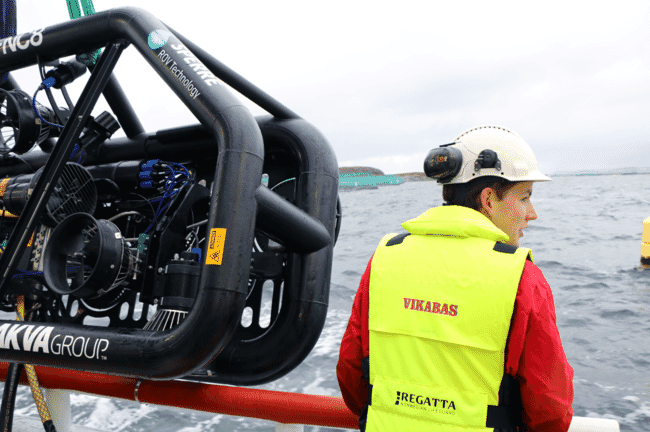
But researchers believe that footage captured by these vehicles will be more accurately assessed by machines. © AKVA
The project* is using deep learning to develop and improve systems that can identify irregularities in salmon cage nets. This is done by feeding a digital neural network with images showing the building blocks of an intact net. These images then enable the programme to react when it observes something out of the ordinary, such as a hole.
Frequent inspections of sea cage nets are intended to help prevent fish from escaping. Escaped farmed salmon may carry disease and can also cause genetic contamination of unique wild salmon strains. And the Norwegian government recently gave notice that it intends to introduce stricter technical requirements for the escape-proof design and operation of fish farms.
Need for improvements
Current standard operations involve the use of a camera-mounted, remotely operated vehicle (ROV) that is launched into a cage and manipulated by an operator who then inspects the images. It is difficult for an operator to concentrate for hours on end looking at a monotonous set of video images. A computer brain, on the other hand, never gets tired or bored, so such operations are ideal for the application of autonomous vehicles using image recognition.
Regardless of whether the images will be assessed by humans or machines, navigating an ROV along a sea cage net is a technically demanding task. The vehicle’s camera has to approach close enough to get clear images without colliding with the net wall.
The researchers are looking into the types of sensor technology that can enable an ROV to determine its spatial position within a sea cage. Such information is key to identifying which part of the net is being inspected at any given time.
It is essential that an ROV knows exactly where it is for all types of autonomous operations. It may have to hold a stable position in the face of strong currents and high seas, or track across the net wall at a predetermined fixed distance.
The result of all this research is a laser camera system for so-called net-relative navigation. Information about the ROV’s distance and angular orientation to the net is obtained with the help of two parallel laser beams that illuminate the net wall. Such measurements are essential if the ROV is to keep an appropriate distance from the net wall without an operator having to make steering adjustments every time the net moves due to currents or wave motion. A lot of exciting research and development is being carried out into autonomous robotic operations, both in research centres and industrial settings. SINTEF sees this as the beginning of a journey of system development that will enhance operations in the aquaculture sector.
Helping to reduce risks for farmers
SFI Exposed is a centre for research-based innovation that works in many fields with a variety of perspectives on the challenges facing offshore aquaculture operations in exposed settings. Its researchers have revealed that there may be some overlap between incidents that increase the risk of fish escapes and those that threaten the safety of facility employees. If employee safety is built into the technology so that it becomes impossible to cause hazard by incorrect use, it will effectively reduce the risk of incidents that result in both fish escapes and injuries to employees. HSE considerations are essential for those personnel whose job it is to release ROVs into fish cages and recover them again. This task sounds simple enough, but it requires a crane-mounted vessel to be brought alongside and moored against the cage. In many situations, personnel have to be deployed along the float ring in order to the release the ROV – a job that involves a lot of difficult lifting. Movement between the vessel and the cage is a risky undertaking at the best of times, and it is in precisely such situations that many sector-related accidents occur. In locations subject to large movements and accelerations due to strong currents, high seas and winds, and where the vessels and facility infrastructure are larger than in sheltered sites, it is vital to have systems in place that make it safe to move between a cage and a moored vessel.
The SFI researchers are looking into developing an advanced robot arm that enables operations to be carried out without any form of contact between the vessel and the cage. They have used model experiments to demonstrate how such an arm can compensate for the relative movements of a vessel and a sea cage. They have also made assessments of any changes that have to be made to existing facilities to enable this technology to be brought into use.
Improved decision support
Better defined operational limits in the form of guidelines as to when operations can be performed or not, may make a valuable contribution towards enhancing safety. SINTEF Ocean researchers have been collecting information about wave, current and weather conditions to help make decisions about whether or not an operation can be carried out to provide a foundation for operational planning.



